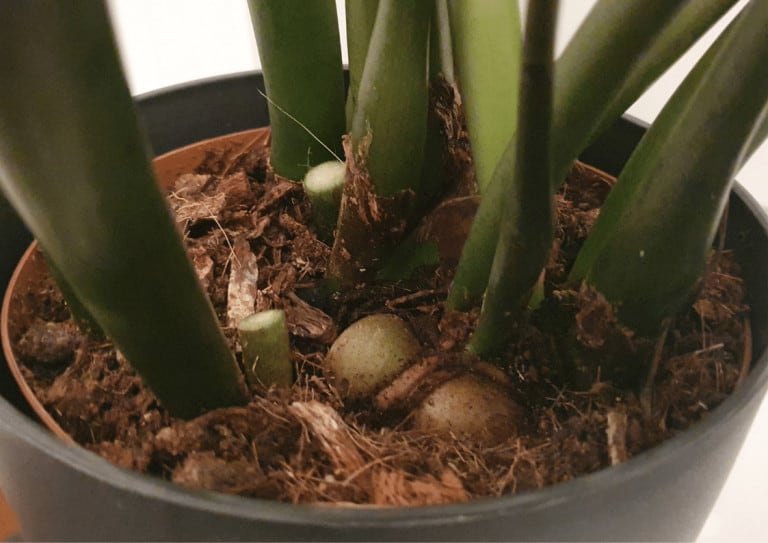What To Do If Your ZZ Plant Has Exposed Root Bulbs?
- Lakeisha Ethans
- March 10, 2022
If you buy something using the retail links in our articles, sometimes we earn a small affiliate commission. This does not impact the products we recommend.
ZZ plants, renowned for their hardiness, are loved for their hardiness and ability to withstand neglect and mistakes. But even plants as resilient as the Zamioculcas zamiifolia need to be looked after well. If you own a ZZ plant, then you’ve likely tried your best to ensure its health and have taken note of any abnormalities that have cropped up.
One particularly common concern for ZZ plant owners has to do with their root bulbs. These bulbs can sometimes become exposed and show visibly above the soil. Owners may be worried that this is a sign of a rootbound plant or that there may be some other issues with it.
In most cases, it is not dangerous for a ZZ plant to have exposed root bulbs, so no action needs to be taken. Some people even intentionally leave the bulbs partially exposed. However, this should be assessed on a case-by-case basis, as there’s a chance that it’s a sign of a rootbound plant that needs repotting.
As with many aspects of plant ownership, you have to take your unique plant’s needs and environment into account when determining the cause of a potential problem. ZZ plants can have exposed root bulbs that are completely safe, but sometimes they point to issues that must be addressed.
This article will give you the information you need to understand about the root bulb on your ZZ plant and when to worry. Some topics we’ll cover include:
- What is a root bulb on a ZZ plant?
- What should I do if my ZZ plant has exposed root bulbs?
- Can I safely leave my ZZ plant’s root bulbs exposed?
- What are the signs of a rootbound ZZ plant?
This post will properly explain what a root bulb is and what to expect when it starts showing its face above the soil.

What is a root bulb on a ZZ plant?
A ZZ plant actually does not have a true root bulb. The round underground storage part of the plant is actually a rhizome, not a bulb. Rhizomes are fleshy, thickened, and swollen stems that are modified to store nutrients. These stem structures develop from an already established plant and grow horizontally, near the surface of the soil.
Of course, this technicality has not stopped many owners from referring to the rhizome on a ZZ plant as a root bulb for the sake of ease. We’ll be continuing to use the term “root bulb” interchangeably with the proper term in this article.
A ZZ plant’s rhizomes store water and nutrients that the plant can draw from as needed. This is why the plant is so famously hardy – it has a quick and easy way to access “backup” sources of food and water if neglected.
Because of how closely they stay to the surface of the soil, root bulbs can become exposed easily on ZZ plants. It is actually recommended that you keep ZZ plant root bulbs not too deeply buried, as covering them up excessively prompts root rot from trapped moisture. But how much exposure is too much?
What should I do if my ZZ plant has exposed root bulbs?
The first thing you should do if your ZZ plant has exposed root bulbs is to determine the cause of that exposure. If the exposure is not due to anything serious, all you need to do is decide whether or not to cover the bulbs back up. Root bulbs live close to the surface, so when you water the plant, the soil gets shifted around and may reveal the rhizome underneath.
But what if the issue is more serious than that? Your ZZ plant may have become rootbound. This simply means that the plant’s roots have outgrown the pot that it is in, causing them to coil over and push the root bulb upwards to the surface due to lack of space. This can stagnate healthy growth.
You can check if your ZZ plant has become rootbound by gently sliding it outwards from its pot. Turn it over and look at the roots. If the roots are very tightly fixed to the pot and are coiled, you should repot the plant to prevent root rot and dying leaves.
A ZZ plant may also show its root bulb if you’re overwatering it. Excessive watering will cause the extra water to blend with soil, releasing the medium via drainage holes.
This reduces the total amount of soil in the pot, causing the rhizome to become exposed. You should also make sure that you’re using gentle water pressure to prevent soil disturbance.
If you think you’re overwatering your plant, try cutting back a little and observing your plant’s reaction. Remember, ZZ plants are resistant to drought and don’t need to be watered very often!
Can I safely leave my ZZ plant’s root bulbs exposed?
If your ZZ plant’s root bulbs are showing only because the soil has fallen away, you can safely leave them exposed. Some ZZ plant owners like having a little bit of the root bulb showing, and you’ll find many who swear by it!
A safely exposed healthy root bulb allows you to gauge the needs of their plant by the look and feel of the rhizome. A squishy, soft surface indicates a need for water, while a hard bulb means it has sufficient water to last. Partially exposed root bulbs can also reduce the risk of root rot.
However, you should note that when the root bulbs are exposed, they’ll dry up more quickly and will need more frequent watering. If you’ll be leaving your ZZ plant unmaintained for a while for any reason, cover the root bulbs back up to ensure the most water retention.

What are the signs of a rootbound ZZ plant?
If you’re worried that your ZZ plant is rootbound, you can keep an eye out for a few signs that it needs more room to grow.
Visual clues are obvious if a ZZ plant is rootbound:
- It may have stopped growing and you might be able to see roots growing out of drainage holes.
- Its leaves may be browning or yellowing and you’ll notice the root bulb forming a cluster as it spirals.
- Leaves will also start to curl and wilt and soil will dry very quickly as the plant dehydrates.
There are different stages of a rootbound state in a ZZ plant. A slightly rootbound ZZ plant will have a root ball that has only just begun to be wrapped in roots. These plants can be left for up to a year safely before they need to be repotted.
On the other hand, a tightly or severely root bounded ZZ plant will have matted roots and may even have completely encompassed the soil. At this point, you must repot your ZZ plant as soon as possible. This may require the act of breaking the current pot to free your plant from its too-small prison.
When choosing a new pot, make sure it has enough space for your ZZ plant. On average, you should expect to need to do this every two to four years, depending on your plant’s growth speed and environment.
Take home message
ZZ plants sometimes have root bulbs that are exposed for completely safe reasons. Shifting soil is one of these potential reasons, and that’s not a cause for alarm. In fact, a little revealed rhizome can help you properly determine when your plant needs watering.
But, at the same time, keep an eye out for more serious issues that underlie the exposed root bulb. Your ZZ plant may have become rootbound or may be receiving too much water. Either way, you should work to rectify these issues as quickly as possible! Being able to recognize the signs of a rootbound plant may be extra helpful in this regard.

Lakeisha Ethans
Houseplant Writer
Mother to two humans and hundreds of plant babies. Lakeisha uses her 15 years of experience as a content writer to specialise in simplifying what you need to know to grow and care for all indoor plants.
Similar Posts
Why Are New Leaves On My Monstera Black?
It's always concerning when a Monstera plant's new leaves are blackened and dying before they even unfurl. Why does it happen and what can you do about it?
My Staghorn Fern Shield Frond Is Brown – Is This Normal?
Leaves and foliage turning brown is often a sign of danger for a plant....however not always! Case in point being the shield fronds of a Staghorn fern.



